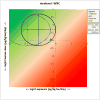APROBA-Plus: A probabilistic tool to evaluate and express uncertainty in hazard characterization and exposure assessment of substances
- PMID: 29074418
- PMCID: PMC5793872
- DOI: 10.1016/j.fct.2017.10.038
APROBA-Plus: A probabilistic tool to evaluate and express uncertainty in hazard characterization and exposure assessment of substances
Abstract
To facilitate the application of probabilistic risk assessment, the WHO released the APROBA tool. This tool applies lognormal uncertainty distributions to the different aspects of the hazard characterization, resulting in a probabilistic health-based guidance value. The current paper describes an extension, APROBA-Plus, which combines the output from the probabilistic hazard characterization with the probabilistic exposure to rapidly characterize risk and its uncertainty. The uncertainty in exposure is graphically compared with the uncertainty in the target human dose, i.e. the dose that complies with the specified protection goals. APROBA-Plus is applied to several case studies, resulting in distinct outcomes and illustrating that APROBA-Plus could serve as a standard extension of routine risk assessments. By visualizing the uncertainties, APROBA-Plus provides a more transparent and informative outcome than the more usual deterministic approaches, so that risk managers can make better informed decisions. For example, APROBA-Plus can help in deciding whether risk-reducing measures are warranted or that a refined risk assessment would first be needed. If the latter, the tool can be used to prioritize possible refinements. APROBA-Plus may also be used to rank substances into different risk categories, based on potential health risks without being compromised by different levels of conservatism that may be associated with point estimates of risk.
Keywords: Communicating uncertainty; Exposure assessment; Probabilistic risk assessment.
Copyright © 2017 Elsevier Ltd. All rights reserved.
Figures




Similar articles
-
Integration of probabilistic exposure assessment and probabilistic hazard characterization.Risk Anal. 2007 Apr;27(2):351-71. doi: 10.1111/j.1539-6924.2007.00887.x. Risk Anal. 2007. PMID: 17511703
-
A probabilistic effect assessment model for hazardous substances at the workplace.Regul Toxicol Pharmacol. 2006 Mar;44(2):172-81. doi: 10.1016/j.yrtph.2005.11.001. Epub 2005 Dec 13. Regul Toxicol Pharmacol. 2006. PMID: 16356615
-
A Unified Probabilistic Framework for Dose-Response Assessment of Human Health Effects.Environ Health Perspect. 2015 Dec;123(12):1241-54. doi: 10.1289/ehp.1409385. Epub 2015 May 22. Environ Health Perspect. 2015. PMID: 26006063 Free PMC article. Review.
-
Assessment of intake from the diet.Food Chem Toxicol. 2002 Feb-Mar;40(2-3):327-85. doi: 10.1016/s0278-6915(01)00113-2. Food Chem Toxicol. 2002. PMID: 11893401 Review.
-
Assessing and reporting uncertainties in dietary exposure analysis: Mapping of uncertainties in a tiered approach.Food Chem Toxicol. 2015 Aug;82:79-95. doi: 10.1016/j.fct.2015.04.007. Epub 2015 Apr 15. Food Chem Toxicol. 2015. PMID: 25890086 Review.
Cited by
-
Probabilistic risk assessment - the keystone for the future of toxicology.ALTEX. 2022;39(1):3-29. doi: 10.14573/altex.2201081. ALTEX. 2022. PMID: 35034131 Free PMC article. Review.
-
The use of canonical dose-response models for benchmark dose analysis of continuous toxicological data.Crit Rev Toxicol. 2025;55(4):437-461. doi: 10.1080/10408444.2025.2464067. Epub 2025 Apr 9. Crit Rev Toxicol. 2025. PMID: 40202288 Review.
-
Uncertainties in the Extrapolation of In Vitro Data in Human Risk Assessment: A Case Study of qIVIVE for Imazalil Using the Monte Carlo Risk Assessment Platform.Chem Res Toxicol. 2025 Jun 16;38(6):1006-1018. doi: 10.1021/acs.chemrestox.4c00287. Epub 2025 May 14. Chem Res Toxicol. 2025. PMID: 40368340 Free PMC article.
-
Bayesian-Based Probabilistic Risk Assessment of Fipronil in Food: A Case Study in Taiwan.Toxics. 2023 Aug 7;11(8):677. doi: 10.3390/toxics11080677. Toxics. 2023. PMID: 37624182 Free PMC article.
-
Reducing uncertainty in dose-response assessments by incorporating Bayesian benchmark dose modeling and in vitro data on population variability.Risk Anal. 2025 Feb;45(2):457-472. doi: 10.1111/risa.17451. Epub 2024 Aug 16. Risk Anal. 2025. PMID: 39148436 Free PMC article.
References
-
- Bokkers BGH, Bakker MI, Boon PE, Bos P, Bosgra S, Van der Heijden GWAM, Janer G, Slob W, Van der Voet H. The practicability of the integrated probabilistic risk assessment (IPRA) approach for substances in food. 2009 http://www.rivm.nl/bibliotheek/rapporten/320121001.pdf.
-
- EFSA. Guidance of the Scientific Committee on a request from EFSA related to Uncertainties in Dietary Exposure Assessment. Request No EFSA-Q-2004-019. EFSA Journal. 2006;438:1–54.
-
- EFSA. Scientific Opinion on risks for animal and public health related to the presence of nivalenol in food and feed. EFSA Journal. 2013;11:3262.
-
- EFSA. Revised DRAFT Guidance on Uncertainty in EFSA Scientific Assessment. Question number: EFSA-Q-2013-00738. in prep. Version of 21 March 2016.
Publication types
MeSH terms
Substances
Grants and funding
LinkOut - more resources
Full Text Sources
Other Literature Sources
Medical

